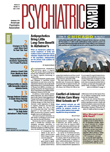There appears to be a decline in the use of some illicit substances in certain populations but an increase of such use among people in their early 50s, according to national survey data presented at APA's annual meeting in May.
By collecting data from various sources, public health officials can monitor substance use trends, predict use patterns in the near future, and take steps to stem rising tides of risky behavior.
According to the most recent National Survey on Drug Use and Health (NSDUH), presented by Moira O'Brien, M.Phil., health scientist administrator at the Division of Epidemiology Services and Prevention Research at the National Institute on Drug Abuse (NIDA), an estimated 20.4 million people aged 12 and older were projected to be using illicit drugs nationwide in 2006, not including tobacco and alcohol.
The NSDUH, an annual survey sponsored by the Substance Abuse and Mental Health Services Administration, also found that the substances most frequently used by people aged 12 and over were marijuana (14.8 million people) and psychotherapeutics for nonmedical reasons (7 million), with cocaine (2.4 million) a distant third. Psychotherapeutics refer to painkillers, tranquilizers, stimulants, and sedatives.
Substance use by teenagers has been in slow decline for the past several years, as shown by data from the NIDA-sponsored Monitoring the Future survey, an annual school-based survey of substance use patterns in youth.
“The overall trend in recent years is good news,” said O'Brien.“ The overall rate of illicit drug use in students in the eighth, 10th, and 12th grades has declined significantly, by 24 percent from 2001 to 2007.”
“Attitude is a good predictor of future use trends,” she noted. For example, while the growing rate of disapproval of marijuana among eighth to 12th graders is a good sign that use of this substance may lessen, youth—especially eighth graders—now perceive ecstasy use as less risky than their older counterparts do. Thus, ecstasy use is expected to increase, and more public health education and interventions may be needed with regard to this drug, she said.
Although substance use trends among youth have captured much public attention, a notable problem revealed by the NSDUH data is “a significant increase of illicit drug use for those aged 50 to 54 from 2002 to 2006,” O'Brien pointed out. “These are people who grew up in 1960s, when drug use became common.” She advised clinicians to be aware of substance use problems in this often-overlooked population. In contrast, the rates in the 55 to 59 age group showed no significant difference between 2002 and 2006.

“The baby-boom generation had an exposure to growing substance use in [the] '60s and '70s,” Timothy Condon, Ph.D., deputy director of NIDA, explained. A large proportion of them have less aversion to drug use than their parents, he said. Adding to the change of attitude toward substance use is the increased availability and social acceptance of prescription drugs, including psychoactive medications, in the past several decades. “This is going to be a serious problem in the future when [they have] more leisure time,” Condon said.
A number of other sources provide different perspectives on substance use in the general population that cannot be captured by large-scale surveys, such as new substances being abused or early signs of a local epidemic.“ Electronic media are changing the dissemination of information about substance abuse,” Edward Boyer, M.D., an assistant professor of emergency medicine at the University of Massachusetts Medical School, told the audience.
He pointed to two major Web sites as sources on which to monitor substance use trends:<www.erowid.org>, a massive online encyclopedia of legal and illegal substances; and<www.drugbuyers.com>, an aggregator of Internet pharmacy data popular among buyers of analgesics. The former site contains firsthand accounts of drug “trips” and pharmacological data on unusual substances. The latter site reflects market shifts (including the black market) in the availability and prices of opiates and psychotherapeutic agents.
NIDA also collects data from sources such as state and local public health departments, poison centers, drug abuse treatment centers, law enforcement and medical examiners' databases, and other surveillance efforts. The Community Epidemiology Work Group (CEWG), a network of public-health representatives from major metropolitan areas and some states across the country, has been meeting semiannually to exchange intelligence and monitor regional convergence and variations in drug abuse trends.
Findings reported at the January CEWG meeting, for example, indicated that the rise of methamphetamine use in Western regions in previous years may be leveling off or in decline, according to O'Brien. She also noted that in the past decade, data from Florida and the Detroit area showed decreasing numbers of heroin-related deaths and a parallel increase in prescription opiate-related deaths from methadone, hydrocodone, and oxycodone. ▪


